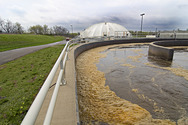
A new Minnesota law aims to provide certainty to communities
and industries in their investments to meet water quality standards while
saving money on long-term wastewater.
“Cities have expressed a lot of frustration over spending
money on new facilities to comply with new standards, and then having to do
more – at a higher cost – a few years down the road when more standards become
law. We worked with many stakeholders and legislators to develop what’s called
regulatory certainty to provide some assurance for their planning and
investments. We see this as a win-win for our waters and for our cities,” said Rebecca
Flood, assistant commissioner of the Minnesota Pollution Control Agency (MPCA).
Regulatory certainty allows the MPCA to hold the line on
nutrient limits in discharge permits for up 20 years in exchange for
communities and industries agreeing to lower nutrients even more than current
standards. Minnesota has water
quality standards for phosphorus and is working on standards for nitrogen.
Both these nutrients can cause algal blooms harmful to aquatic life and
recreation. Nitrogen can also be toxic to fish and other aquatic life, as well
as harmful to humans in drinking water.
This approach takes the uncertainty out of planning for
facilities needing to upgrade or build systems to comply with phosphorus
limits. By incorporating nitrogen removal too, they can avoid higher costs to
comply with new standards in 5-10 years.
Regulatory certainty also allows Minnesota to start reducing
nitrogen discharged by wastewater treatment facilities ahead of adopting a
standard. Minnesota finalized a statewide Nutrient
Reduction Strategy in 2014 that calls for a 45% reduction in nutrients in
the Mississippi River Basin by 2040 to protect downstream waters all the way to
the Gulf of Mexico. For phosphorus,
that’s a reduction from 4,600 tons per year to 2,500 tons, and for nitrogen,
91,000 tons a year to 50,000 tons. This strategy includes an interim reduction
goal for the Mississippi River of 20% by 2025.
Instead of waiting for the nitrogen standard to be developed
and mandated, the regulatory certainty approach helps Minnesota take action now
to protect lakes and rivers here as well as downstream.
For more information on regulatory certainty, attend the meeting below or contact Joel Peck, MPCA municipal liasion, as listed below.
|